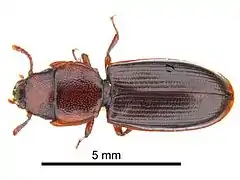Tenebroides mauritanicus
Tenebroides mauritanicus, commonly known as the cadelle, is a cosmopolitan and common pest in storehouses and granaries. Adults and larvae feed on grain and grain products, prey upon other insects infesting grain, and bore into wood. They typically pupate in wood cavities that they make. It is one of the longest lived insects that attacks stored grain and is very destructive and easily dispersed. It is also one of the largest (body length 10 mm.).[1]
| Tenebroides mauritanicus | |
|---|---|
 | |
| Scientific classification | |
| Kingdom: | |
| Phylum: | |
| Class: | |
| Order: | |
| Family: | |
| Genus: | |
| Species: | T. mauritanicus |
| Binomial name | |
| Tenebroides mauritanicus | |
| Synonyms | |
| |
The larvae were nicknamed "bargemen" by sailors because they frequently infested ships' biscuits and were noticed when they would crawl out of the biscuits and onto the "barge", a small tub used to hold biscuits on the mess table.[2]
References
- Cotton, R.T. (1926). The Cadelle. Washington DC: U.S. Dept. of Agriculture. Department bulletin No. 1428.
- Macdonald, Janet (2014). Feeding Nelson's Navy: The True Story of Food at Sea in the Georgian Era. Barnsley, S. Yorkshire: Frontline Books. ISBN 978-1848327474.
External links
Wikimedia Commons has media related to Category:Tenebroides mauritanicus.
Wikispecies has information related to Tenebroides mauritanicus.
- University of Kentucky
- ZinRus Very high quality image.
See also Home stored product entomology
This article is issued from Wikipedia. The text is licensed under Creative Commons - Attribution - Sharealike. Additional terms may apply for the media files.